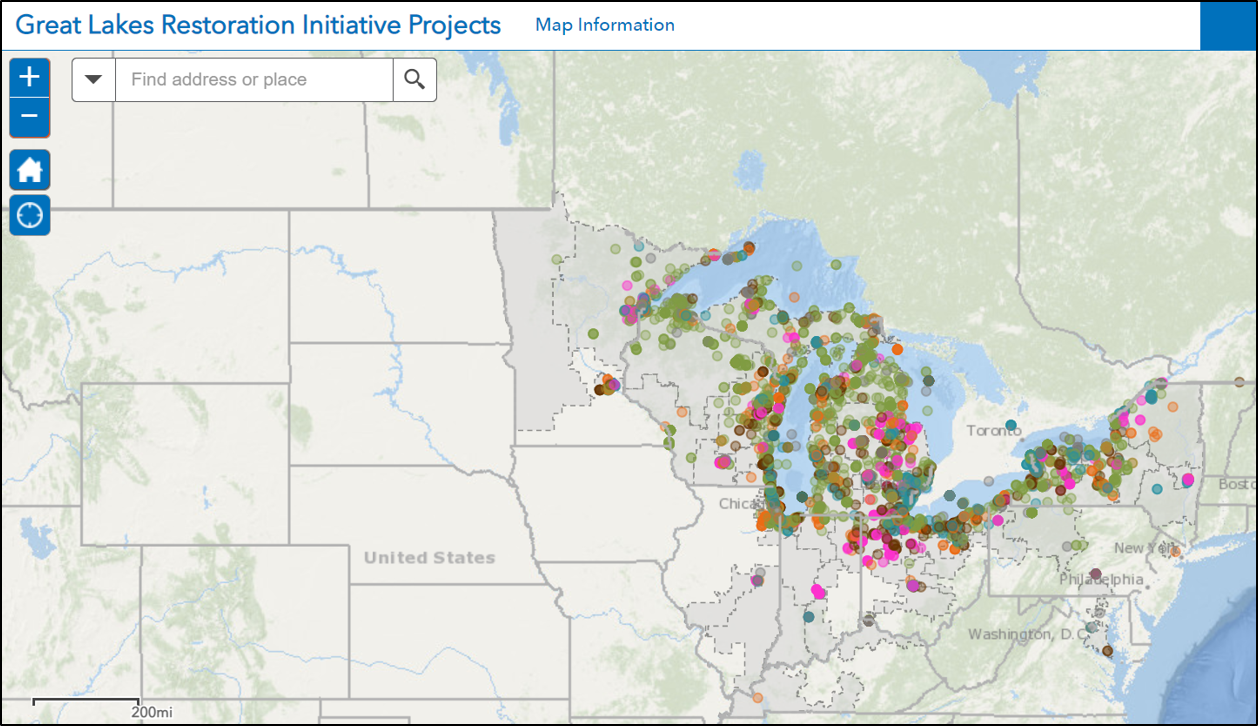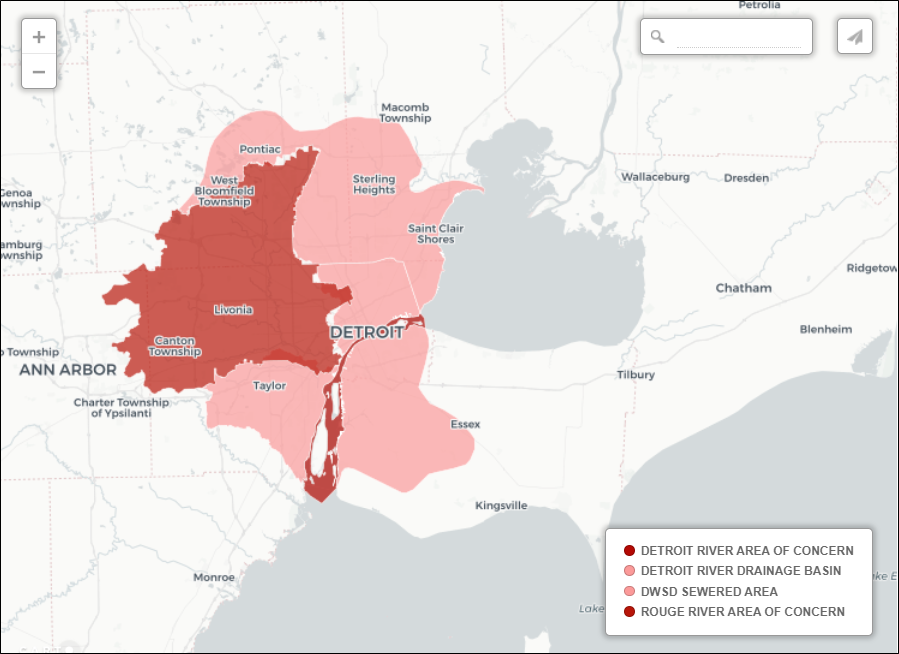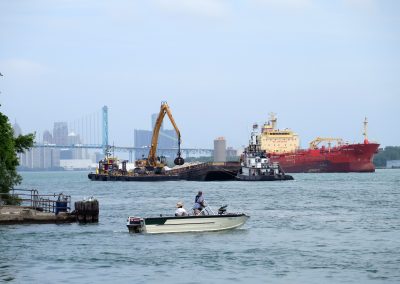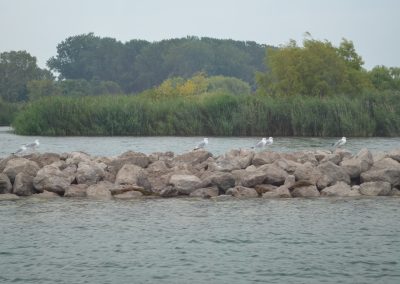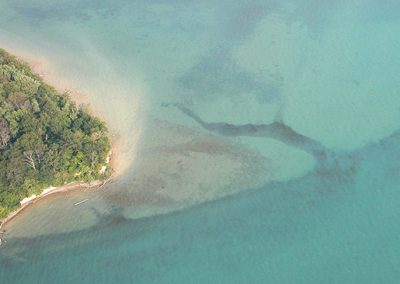Ecosystem Services and Restoration
Protection and restoration of Great Lakes ecosystem services and restoration is vital, as they contain 95 percent of the surface freshwater in the United States and more coastline than the entire East Coast.
The Great Lakes provide significant environmental, economic, and social value to the region and nation. Part of the largest freshwater ecosystem in the world and home to thousands of plant and animal species, the Great Lakes are our country’s primary freshwater supply and economic driver in the region. Recognizing the importance of the Great Lakes and the years of degradation and abuse this vital national resource has suffered, work is needed to clean up toxic hot spots, restore degraded habitat, and reduce nutrient loadings in order to maintain this precious resource.
With our partners at NOAA GLERL, CIGLR is committed to developing information products, predictive models, and strategies to combat and manage ecosystem services and restoration in the Great Lakes region. Our activities in this area include:
1. Great Lakes Shoreline Restoration
A significant portion of the work overseen by the NOAA Restoration Center (RC) in the Great Lakes focuses on using Great Lakes Restoration Initiative (GLRI) funds to implement habitat restoration projects, including the restoration, protection, and enhancement of shorelines and nearshore aquatic habitats that have been damaged and/or compromised by historical activity. Given the relatively common practice of shoreline restoration/enhancement throughout the Great Lakes, NOAA is interested in understanding the ecological and physical outcomes of these efforts and developing a robust and consistent method of evaluating these projects to gauge restoration success and to support proper adaptive management.
Common among Great Lakes habitat restoration techniques is enhancement of shoreline and nearshore aquatic habitats, an important habitat type that benefits native fish and other freshwater species in the Great Lakes, as well as other systems. Multiple techniques are often used to achieve target outcomes, including grading and stabilization with natural materials, enhancement of riparian vegetation, and addition of nearshore habitat structure/complexity. Stakeholder motivations for shoreline restoration projects often include process-based drivers (e.g., sedimentation or other water quality concerns) in addition to species- or habitat-based drivers. This shoreline restoration project plans to enhance habitat for native fish and wildlife (including increased structural complexity, enhanced native vegetation, reduced invasive vegetation, etc.); improve community characteristics (e.g., abundance, diversity, biomass) of target species; improve stability at the land-water interface (e.g., improved slope, reduced erosion/sedimentation); increase resilience to storms, floods, and climate variability. The goal of this project is to help inform and understand drivers (why are we doing this and how do we measure) for focused shoreline restoration and standardized monitoring.
2. Detroit and Rouge River Restoration
The Rouge River and the Detroit River are two of the Great Lakes regions’ Areas of Concern (AOC) with long histories of complex industrial use, municipal waste discharge and a resultant legacy of sediment contamination. While significant work has been completed over the past two five-year cycles of Action Plans under the Great Lakes Restoration Initiative (GLRI) (and the Great Lakes Legacy Act) considerable work in these two urban watersheds remains. A substantial portion of this work over the next decade will continue to address legacy contamination in the near shore and off-shore sediments of these two rivers.
Under the Great Lakes Legacy Act funding, a component of the GLRI administered through EPA, there is a requirement for significant local (non-federal) match for dollars expended. This requirement is a minimum of 35% of total project expenditures and can be provided as in-kind value or as cash match from sources other than from federally-derived funding. Current estimates place the restoration for sediment removal and management in excess of $2 billion dollars, which would necessitate a local match in excess of $700 million dollars over the next ten years for sediment management and removal.
The purpose of this project is to methodically and thoughtfully engage with and align local and regional parties in the Detroit and Rouge River Watersheds to establish a clear and timely success path for developing non-federal match for sediment remediation. We seek to (1) develop a comprehensive, community-based solicitation strategy for non-federal cost share (35% of total project costs) from state, local, corporate and philanthropic partners for pressing ecological and sediment restoration in the Detroit and Rouge River AOC Systems; (2) link restoration of Detroit and Rouge River with other large scale economic and social transformational investments in Southeast Michigan; (3) build local support for the 35% cost share and link that support to other pressing and important contemporaneous economic investments within Detroit and across Southeast Michigan; (4) design innovative approaches for developing an adequate capital stack for meeting the 35% non-federal cost share; (5) explore multi-party mechanisms and innovative approaches to funding non-federal cost share (e.g., regional impact bonding) and; (6) solicit commitments towards the 35% non-federal match requirements. Community response to the need for such a large amount of non-federal match while there is such great need for restoration will be of great interest and applicability to other such large-scale restoration projects.
The project will focus first on developing a funding model for the Rouge River watershed, and will then adapt and scale the approach for the Detroit River watershed.
3. Great Lakes Observing System for Human Dimensions
Human dimensions research seeks to understand the relationships that people have with the natural environment. Using social science methods, we can evaluate the value of ecosystem services, desired natural resource management outcomes, and the potential human impacts of natural resources management decisions. Our growing social science program at CIGLR is making progress toward understanding the human dimensions of Great Lakes natural resources and sustainability. In one study, we are laying the groundwork for a Great Lakes regional social science observatory.
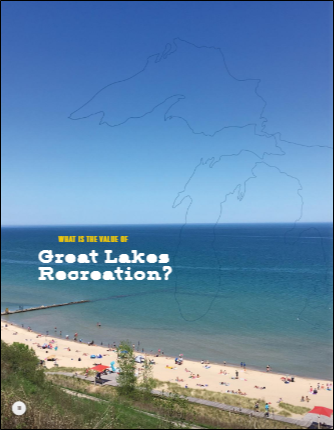
What’s the recreational value of the Great Lakes and who decides that? Terrific read on work by UW-Milwaukee School of Freshwater Sciences professor Tracy Boyer and colleagues on the science of public perceptions about our inland seas. Click image to read.
Tracy Boyer, PhD (University of Wisconsin-Milwaukee) and colleagues at Michigan State University, Cornell University, and Loyola University Chicago are working to investigate and create a baseline Great Lakes regional social science observatory by assessing consumer Recreational Value and the importance of NOAA forecast tools. They are estimating Recreational Value using an economic valuation method called a travel-cost model, approximating the value of a visit to a Great Lake. They then employ contingent valuation experiments to measure how households use and value available NOAA forecasting tools such as the Lake Erie Harmful Algal Bloom Tracker and the National Weather Service (NWS) Beach Hazard statements to modify behavior and travel.
In the fall of 2019, the observatory generated a unique dataset of over 10,000 individual surveys from residents of the eight U.S. Great Lakes states and Ontario, Canada. Currently, they are examining the surveys for the variety of recreational uses (e.g., angling, beach visitation, sightseeing) that each resident disclosed. Preliminary findings show that the Great Lakes are a significant regional attraction for recreation and the majority of those surveyed find value in the available forecasting systems from NOAA. Seventy-six percent of respondents have visited a Great Lake at some point in their lives, and almost 54 percent of those who have visited have done so within the last year. And of those who visited in the last year, almost 75 percent took more than one trip (averaging two trips) to different and unique locations. Lake Michigan and the southern shoreline of Lake Erie were visited the most. This study is unique as it considers travel for multiple recreational uses in the Great Lakes. Collecting accurate data and survey responses over a large geographic region is uncommon and will be a unique contribution to the economic valuation literature.
Stay up-to-date on the most recent news and scientific media generated from our Ecosystem Services and Restoration research here:
Products & Resources
- Detroit River AOC (website)
- Friends of the Detroit River (website)
- Friends of the Rouge River (website)
- Great Lakes Restoration at NOAA and GLERL (NOAA GLERL factsheet)
- Great Lakes Crossword Puzzle (game)
- Great Lakes Word Find and Crossword Puzzle (game)
News
- Water Quality Modeling in the Great Lakes, CIGLR 2020 Fall eNews, 12/2020
- Synthesizing the Great Lakes Restoration Initiative’s Funding Efforts, CIGLR 2020 Summer eNews, 09/2020
- Assessing Environmental Changes in the Lake Erie Ecosystem, CIGLR 2020 Winter eNews, 03/2020
- Linking Land and Lakes: Protecting Great Lakes’ Coastal Wetlands, PBS, 10/17/2019
- Large Lakes Worldwide Share Many of the Same Threats, Great Lakes Echo, 8/15/2019
- Understanding Muskegon Lake – a Great Lakes Estuary under Stress, CIGLR 2017 Summer eNews, 09/2017
Publications
Cable, R.N., D. Beletsky, R. Beletsky, B.W. Locke, K. Wigginton and M.B. Duhaime. 2017. Distribution and modeled transport of plastic pollution in the Great Lakes, the world’s largest freshwater resource. Frontiers in Environmental Science. 5(45). (DOI:10.3389/fenvs.2017.00045). [Altmetric Score]
Kao, Y-C., S. Adlerstein and E.S. Rutherford. 2016. Assessment of bottom-up and top-down controls on the collapse of alewives Alosa pseudoharengus in Lake Huron. Ecosystems. 19:803-831. (DOI:10.1007/s10021-016-9969-y). [Altmetric Score]
Maguire, T.J. and S.O.C. Mundle. 2020. Citizen science data shows temperature driven declines in riverine sentinel invertebrates. Environmental Science & Technology Letters.(DOI:10.1021/acs.estlett.0c00206). [Altmetric Score]
Shahraki, A.H., D. Heath and S.R. Chaganti. 2019. Recreational Water Monitoring: Nanofluidic qRT‐PCR Chip for Assessing Beach Water Safety. Environmental DNA. (DOI:10.1002/edn3.30). [Altmetric Score]
Steinman, A.D., Cardinale, B.J., Munns, W.R., Ogdahl, M.E., Allan, J.D., Angadi, T., Bartlett, S., Brauman, K., Byappanahalli, M., Doss, M., Dupont, D., Johns, A., Kashian, D., Lupi, F., McIntyre, P., Miller, T., Moore, M., Muenich, R.L., Poudel, R., Price, J., Provencher, B., Rea, A., Read, J., Renzetti, S. Sohngen, B. and Washburn, E. 2017. Ecosystem Services in the Great Lakes. Journal of Great Lakes Research. 43:161-168. (DOI:10.1016/j.jglr.2017.02.004). [Altmetric Score]
Stow, C.A., Q. Liu and E.J. Anderson. 2019. Nutrient Loading and Nonstationarity: The Importance of Differentiating the Independent Effects of Tributary Flow and Nutrient Concentration. WIREs Water. (DOI:10.1002/wat2.1396). [Altmetric Score]
Wang, L., C.M. Riseng, L.A. Mason, K.E. Wehrly, E.S. Rutherford, J.E. McKenna, Jr., C. Castiglione, L.B. Johnson, D. Infante, S.E. Sowa, M. Robertson, J. Schaeffer, M. Khoury, J. Gaiot, T. Hollenhorst, C. Brooks and M. Coscarelli. 2015. A spatial classification and database for management, research, and policy making: The Great Lakes aquatic habitat framework. Journal of Great Lakes Research. 41:584-596. (DOI:10.1016/j.jglr.2015.03.017). [Altmetric Score]
PrincipaI Investigator(s):
Casey Godwin (CIGLR)
Jon Allen (UM)
Karen Alofs (UM)
Tracy Boyer (UW Milwaukee)
Catherine Kling (Cornell)
Frank Lupi (MSU)
NOAA Technical Lead(s):
Julie Simmons (NOAA RC)
Invasive Species Photo Gallery
Photos from substrate placement at the Fort Wayne reef restoration site on the Detroit River, 2018. Photo credit: Lynn Vaccaro.
Restoration work at Stony Island has supported critical habitat for shorebirds like gulls, terns and cormorants. Photo Credit: Michigan Sea Grant.
Sediment eroding off of Sugar Island’s south-facing cliff has impacted local fish populations in the Detroit River. Recommended funding would help to restore this important fish spawning habitat. Photo Credit: Friends of the Detroit River.
Photos from substrate placement at the Fort Wayne reef restoration site on the Detroit River, 2018. Photo credit: Lynn Vaccaro.
Video Library
Follow the work of Great Lakes researchers as we travel 5,000 miles and talk to more than 40 experts on the vital role coastal wetlands play in keeping the Great Lakes healthy. Learn more about this small but mighty ecosystem and the importance of preserving them for future generations in “Linking Land and Lakes: Protecting Great Lakes’ Coastal Wetlands.” Watch full video: https://www.pbs.org/video/linking-land-and-lakes-hdo22u/
Video Library
Learn more about recent work in the Detroit River to enhance the environment, recreational opportunities, and our blue economy. If you would like to become a member of Friends of the Detroit River please click on this link: https://detroitriver.org/membership.html

